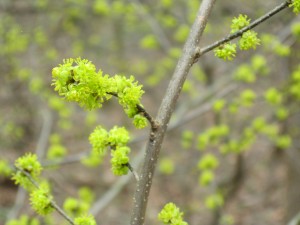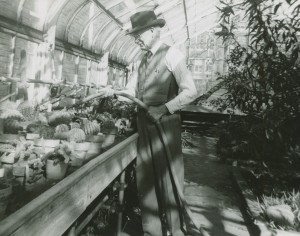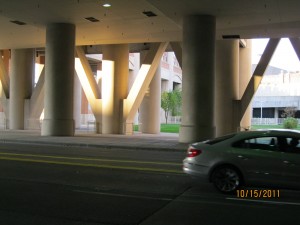Last August (2011), I wrote a post mentioning that late summer is the flowering time of a rare plant of beech-maple forest, the three birds orchid, Triphora trianthophora. It’s rare nearly everywhere and seemingly was gone from most or all of the few known Michigan stations. I invited Michigan field naturalists to go out and find a place where the plant still lived.
Later that fall (2011), I received an email from Michigan botanist Charles Peirce with the following information:
1. There’s a photographer, Aaron Strouse, in Clare, Michigan who has superior photographs taken this summer. He has displayed them on flickr.
2. There is supposed to be a colony of Three Birds Orchid in Sleeping Bear Dunes National Lakeshore [Leelanau County]. However, [the] location information covers a large amount of habitat and turns out to be of little use.
And now (2012), Indiana botanist Scott Namestnik has posted a comment to my 2011 essay:
I am happy to report that as of yesterday [3 September], Triphora trianthophora is alive and well in Michigan! (At least at one location). I was at a site in Berrien County yesterday botanizing with a friend when by complete luck I caught a quick glimpse of a tiny white flower on the mesic forest floor. After a double take, I realized that I was looking at Triphora trianthophora! We first saw a couple of plants, then a couple more, and then I realized that the popuation was much more extensive than we orignally suspected. In all, it covered an area ~30′ x 40′, and we estimated 100 plants, though there are probably more. From what I can tell, this is a different site from where it was previously known in Berrien County. I’ve notified a friend at MNFI [Michigan Natural Features Inventory], and we collected notes on the population that I’ve passed to my friend at MNFI.
The MNFI account for three birds orchid available on the web lists 12 stations in 10 counties. They run from Berrien and Cass in the southwest corner of Michigan to Leelanau County three-quarters of the way up the Lake Michigan coast. However, the MNFI web account includes only historic records, between 1880 amd 1981. None of the records is farther east than Ionia County; most are in counties directly adjacent to Lake Michigan.
From the information provided by Charles Peirce and Scott Namestnik, we know that three birds still exists in Michigan, but it remains a rare plant. It also is an inconspicuous plant–inconspicuous in ways that most plants never thought of. It blooms at a time–late July to September–when few biologists, or anybody else, has much reason to be in its habitat. Under the dense canopy, the beech-maple forest is dark and buggy, with mosquitos and deer flies. Mesic forest is outstandingly a site for spring ephemerals, though some other plants bloom through late spring and early summer. But by August almost no other plant species is in flower, except for a few late blossoms on thigh-high plants of horse nettle, Laportea canadensis.
Not much else is happening in these woods either. A few plants have fruits ripening–bottle-brush grass and dolls eyes, for example. and there are a few fresh fungi such as large white puff balls and coral fungi; however, most of the prime mushrooms appear in spring, early summer, or a bit later in the fall.
So rare though it may be, three birds is also easily missed.
Here’s a little more information about the species reprinted from my earlier post:
Three birds is a short plant, 6 inches or thereabouts. There is much yet to learn about its habitat and life history. Within its mesophytic forest home, it’s said to favor sites where there’s a build-up of leaf litter and humus. Probably this means small depressions. Leaves accumulate other places, such as between two large fallen trunks, but I’m not sure if that microhabitat would be long-lived enough to allow time for the orchid to invade. But maybe it would. From observations of the Michigan botanist Fred Case in his Orchids of the Western Great Lakes Region (Cranbrook Institute of Science, 1987), I suspect that most dispersal is through underground tuberoids that are dug up, carried off, and stored in the duff and litter by red squirrels, or perhaps chipmunks.
Late in the summer, fleshy stems sprout rapidly from the underground tuberoids. Each plant bears only a few leaves which are oval, alternate, and clasp the stem. Usually there will be a few stems in a clump. Not long after the plants appear, one or occasionally more of the buds open. Flowering is possibly triggered by a couple of chilly nights in a row. It is reported that most of the plants in a given area produce their first blooms at the same time. After a day or so, the first set of blossoms shrivel, and in a few days, a second round of flowering may occur, and perhaps a third.
The flowers (often three per plant) are recognizably orchids but small, perhaps about an inch wide and an inch tall and are mostly whitish or pinkish with a greenish bearded stripe on the lip. The fruits last for a couple of weeks before slits develop that allow the release of the spore-like seeds in the following days. Although the plants are not at their showiest when they’re in fruit, this is probably the longest period of their above-ground life.
If three birds is still in Berrien County and Leelanau , why shouldn’t it be in suitable habitat in the dozen or so counties in between? Now may be the prime time to look.
Good hunting!
Acknowledgments: My thanks to Charles Peirce and Scott Namestnik. Both have interesting blogs. Peirce’s Michigan Wildflowers, has photos of many of the vascular plants of Michigan, arranged alphabetically (separate indexes for common and scientific names), The website makes an excellent aid for identifying or verifying Michigan plants. His photos of Triphora trianthophora are dated 2012, indicating that he has been fortunate enough to visit a Michigan site for the species recently.
One of Namestnik’s blogs, Through Handlens and Binoculars, is devoted to natural history observations by him and his wife, particularly in the highly ecotonal region where they live in the northwest corner of Indiana (lapping over into far southwest Michigan.











